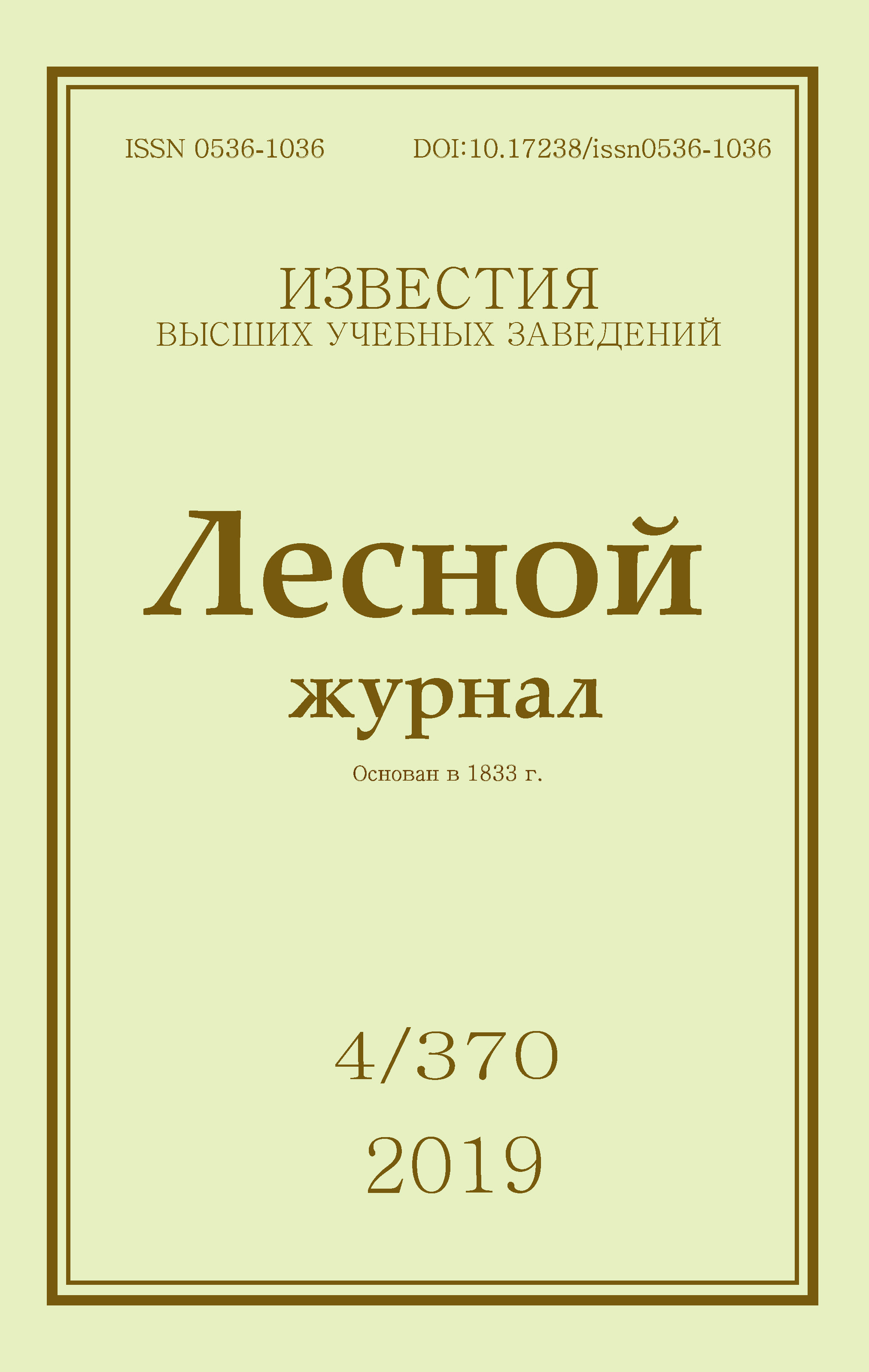The Current State of the Shelterbelt Featuring English Oak (Quercus robur L.) and Norway Maple (Acer platanoides L.)
DOI:
https://doi.org/10.17238/issn0536-1036.2019.4.34Keywords:
shelterbelt, English oak, Norway maple, forest stand, shrub layer, ground cover, average tree diameter, total and average tree crosscut areaAbstract
Shelterbelt forests are one of the most important factors of ecological optimization of agrolandscape. The research purpose is to analyse the current state of the forest belt with the involvement of English oak (Quercus robur L.) and Norway maple (Acer platanoides L.) in the vicinity of Zolotaryovka village (Stanichno-Luganskiy district of Lugansk region, Ukraine) and development of necessary measures for belt’s regeneration. Archival data on the time of planting and age of the studied object were not found out. Shelterbelts in Lugansk region were created in accordance with Stalin’s plan for the transformation of nature, which was designed for the period from 1949 till 1965. We laid out two permanent trial plots due to the branch standard OST 56-69–83 in the studied plantation. We determined the composition of the shelterbelt, the diameter and mean height of trees and their condition by Kraft using the results of the enumerative inventory. The vital status of trees was estimated based on the “Sanitary regulations in the forests of the Russian Federation”. Undergrowth of Norway maple, Tatarian maple and mahaleb cherry (Prunus mahaleb L.) is the most numerous under the canopy of parent plantations. These species originally were not in the stand composition of the shelterbelt. It has been found that in the stand there is a forest-forming process aimed at formation of a forest biocenosis with predominance of Norway maple. The decisive factor affecting the condition of oak trees in the shelterbelts is the condition of their last rows. The survival rate of oak depends on the fall of Norway maple with the natural formation of forest stand in the plantation created by the corridor or ordinary way. It was revealed that it is necessary to carry out increment felling in the rows of Norway maple in order to improve the conditions for growth and development of English oak in the studied plantation. If a set of measures for promotion of tree regeneration in the shelterbelt is not carried out, then in the future there may be a change of English oak to Norway maple and Tatarian maple trees.
For citation: Gribacheva O.V. The Current State of the Shelterbelt Featuring English Oak (Quercus robur L.) and Norway Maple (Acer platanoides L.). Lesnoy Zhurnal [Forestry Journal], 2019, no. 4, pp. 34–44. DOI: 10.17238/issn0536-1036.2019.4.34
Downloads
References
Логгинов Б.И. Агролесомелиоративное районирование Украинской ССР. Киев: Госсельхозиздат УССР, 1991. С. 307–319.
Манаенков А.С. Закономерности водного режима, роста и долговечности искусственных древостоев в засушливых условиях // Изв. СПбЛТА. 2017. Вып. 221. С. 91–106. DOI: 10.21266/2079-4304.2017.221.91-106
Методическое руководство по повышению долговечности широкополосных защитных насаждений на юге европейской территории России. Волгоград: ВНИАЛМИ, 2013. 56 с.
Лесоустроительная инструкция: утв. приказом № 31 МПР России от 06.02.2008 г. Режим доступа: www.consultant.ru/document/cons_doc_LAW_77100/ (дата обращения: 12.12.2018 г.).
ОСТ 56-69–83. Площади пробные лесоустроительные. Метод закладки. М.: ЦБНТИЛХ, 1984. 50 с.
Павловский Е.С. Выращивание защитных насаждений в Каменной степи. М.: Лесн. пром-сть, 1965. 170 с.
Павловский Е.С. Лесоводственные особенности агролесомелиоративных насаждений Каменной степи: автореф. дис. … д-ра с.-х. наук. Воронеж, 1969. 38 с.
Раменский Л.Г. Введение в комплексное почвенно-геоботаническое исследование земель. М.: Сельхозгиз, 1938. 620 с.
Рыжков О.В. Состояние и развитие дубрав Центральной лесостепи. Тула: Наука, 2001. 182 с.
Рябцев И.С. Возобновление широколиственных пород под пологом древостоя: дис. … д-ра биол. наук. СПб., 2014. 180 с.
Рябцев И.С., Тиходеева М.Ю., Рябцева И.М. Подпологовое возобновление лесообразующих пород в широколиственных лесах разного возраста с господством дуба черешчатого (Quercus robur L.) // Вестн. С.-Петерб. ун-та. Сер. 3: Биология. 2009. Вып. 2. С. 12–21.
Санитарные правила в лесах Российской Федерации: утв. приказом № 301 МПР России от 19.11.2007 г. Режим доступа: www.consultant.ru/document/cons_doc_LAW_72929/ (дата обращения: 12.12.2018).
Сороговец П.Е. К экологии дубового самосева (влияние света на рост и развитие) // Бюл. Ин-та биологии. 1957. Вып. III. С. 28–34.
Сукачёв В.Н. Руководство к исследованию типов леса. М.; Л.: Гос. изд-во с.-х. и колхоз.-кооператив. лит., 1931. 328 с.
Фисуненко О.П., Жадант В.И. Природа Луганской области. Луганск: ЛГПИ им. Т.Г. Шевченко, 1994. 233 с.
Brandle J.R., Ruark G. Working Trees: Windbreaks for Carbon in the U.S. // Inside Agroforestry. 2000/2001. Vol. Fall 2000 / Winter 2001: Carbon. Pp. 1; 9.
Coates K.D. Tree Recruitment in Gaps of Various Size, Clearcuts and Undisturbed Mixed Forest of Interior British Columbia, Canada // Forest Ecology and Management. 2002. Vol. 155, iss. 1-3. Pp. 387–398. DOI: 10.1016/S0378-1127(01)00574-6
Concha J.Y., Alegre J.C., Pocomucha V. Determination of Carbon Reservations in the Aerial Biomass of Agroforestry Systems of Theobroma cacao L. in the Department of San Martin, Peru // Ecologia Aplicada. 2007. Vol. 6, no. 1-2. Pp. 75–82.
Jose S. Agroforestry for Ecosystem Services and Environmental Benefits: An Overview // Agroforestry Systems. 2009. Vol. 76, iss. 1. Pp. 1–10. DOI: 10.1007/s10457-009-9229-7
Lacombe S., Bradley R.L., Hamel C., Beaulieu C. Do Tree-Based Intercropping Systems Increase the Diversity and Stability of Soil Microbial Communities? // Agriculture, Ecosystems and Environment. 2009. Vol. 131, iss. 1-2. Рp. 25–31. DOI: 10.1016/j.agee.2008.08.010
Reynolds P.E., Simpson J.A., Thevathasan N.V., Gordon A.M. Effects of Tree Competition on Corn and Soybean Photosynthesis, Growth, and Yield in a Temperate Tree-Based Agroforestry Intercropping System in Southern Ontario, Canada // Ecological Engineering. 2007. Vol. 29, iss. 4. Pp. 362–371. DOI: 10.1016/j.ecoleng.2006.09.024
Walther G.-R., Post E., Convey P., Menzel A., Parmesan C., Beebee T.J.C., Fromentin J.-M., Hoegh-Culdberg O., Bairlein F. Ecological Responses to Recent Climate Change // Nature. 2002. Vol. 416, no. 6879. Pp. 389–395.
Поступила 21.02.19







